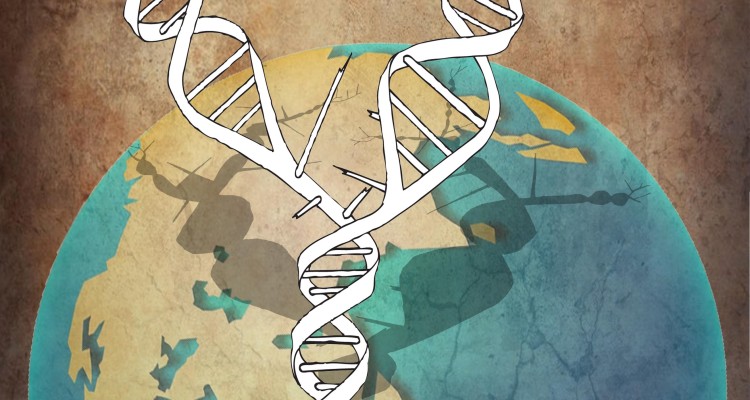While most family trees typically consist of siblings, cousins, parents and grandparents, Dr. Spencer Wells, a leading population geneticist and anthropologist, believes that “everybody on planet Earth falls under the lines of one family tree.”
It all started with a man named Y-chromosomal Adam who lived in Africa around 60,000–90,000 years ago. According to Wells, all humans are descendents of this man.
This claim has garnered Wells much backing on his studies of genetics and answering the question of where all humans come from. He believes that, with the study of genetics through human DNA and of Y-chromosomal Adam, he can close the gaps in our knowledge of human migration and ancestry.
“We’re really trying to piece together the story of the human journey,” said Wells, director of the Genographic Project from National Geographic and International Business Machines Corporation (IBM). “How we’re all related to each other and the story of how closely related we really are: That is the social takeaway.”
Led by Wells, the Genographic Project has gathered more than 660,000 participants who are willing to have their DNA tested. He has distributed his findings all around the world to gain more support, even speaking at a 2007 TED Conference where he spoke about human diversity.
Wells spoke at the Regina A. Quick Center for the Arts this past Thursday, closing the Open Visions Forum series for this school year. As said in the lecture entitled “The Human Journey: A Genetic Odyssey, ” this National Geographic explorer-in-residence believes that by studying humankind’s family tree, he can answer many of life’s questions.
He first asked the audience of approximately 150 people: “Are we all related to each other?” and “Where did we originate?” The answer to these can be seen in DNA. DNA is a nucleic acid that encodes the genetics used in the development and functioning of all living organisms. A basic sample of DNA can help any human trace his or her ancestry.
“In every generation, all of the genome information from the DNA has to be copied to be passed on,” said Wells. “Humans are, in fact, 99.9% identical at the DNA level.
Wells has traveled all around the world to take DNA samples to help trace ancestry. He’s gone to Asia and Africa and his genetic studies in Africa led him to the Saharan Gateway theory.
Wells stated that humans originated in sub-Saharan Africa and by analyzing DNA from people in all regions, Wells was led to the country of Chad in Africa in 2005 when the Genographic Project began. Here, he learned about the many different languages that are spoken and studied human diversity in the country. He collected vast amounts of DNA and was able to trace what may be Y-chromosomal Adam, the oldest ancestor of humans.
“This is a sign that at some point in the past, this [African] region was a little bit more inhabitable,” said Wells. “What today is a very inhospitable desert might have been a nicer place several thousand years ago.”
The next topic explaining human ancestry that Wells discussed was climate change. About 50,000 years ago, the sub-Saharan Africans started migrating to southern Africa and the Middle East. However, just 10,000 years later, these people started moving back to sub-Saharan Africa. This trend continued every tens of thousands of years with just some ancestors vastly moving locations. Wells believes that this trend has to do with weather.
“Is climate change the major determinant of ancient migration routes?” Wells asked. “Probably so; that seems to be the case.”
To further answer such questions, Wells hopes that the Genographic Project will allow him to trace these ancestors and their migration routes as far back as possible. He has already gathered much support from 140 countries and has gotten $2.2 million in grants from donors.
“We use genetics to study the details of these migratory routes, but beyond that, there’s a message which is that we’re all much more closely related than you might have suspected,” said Wells about the Genographic Project. “We’re making use of the latest technology to do this, but we can’t predict (the future) with any degree of certainty.”
“I liked his emphasis on how we’re all really connected,” said audience member Chris Van Akin ’16 about Dr. Wells’ discussion. “It makes you really think that we, as a species, are much more connected than a lot of us tend to think. I’m surprised by the amount of evolution we’ve had over the years.”
“I’m a Biology major, so a lot of these things have come up in my classes,” said Gresi Kello ‘14. “I was expecting more of the hard-hitting science, but he is coming from an anthropological background. I still thought all his insights were so interesting.”
The professors who attended this talk were very impressed with Dr. Wells’ presentation, as well.
“Dr. Spencer Wells wound a spellbinding web taking us from primordial human origins up to mysteries geneticists are unlocking about the DNA of our own grandchildren yet to be born,” Dr. Philip Eliasoph, Open Visions Forum founder and director and professor of art history, noted.
“Taking us on a pioneering courageously difficult Land Rover drive from London to outer Mongolia to collect the DNA samples of thousands of Genghis Khan’s descendants, Wells was smart, informative, and down to earth,” he stated. “That guy on the Quick Center stage was an authentic Indian Jones searching for the scientific clues of the human journey from Neanderthals to Neo-lithic tool makers, artisans, and spirit doctors.”
Aside from his work on this project, Wells’ fascination with the past has led him to books and documentary projects.
“We are an incredibly diverse species,” said Wells. “It’s all about answering those basic human questions that we all have because there are so many fascinating possibilities about our ancestry and origins.”


Leave a Reply